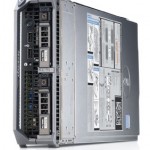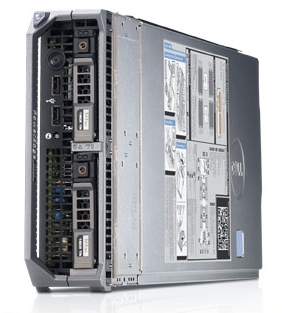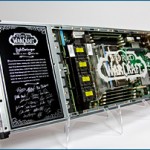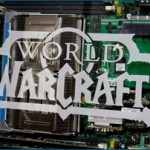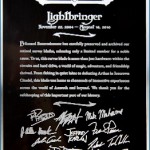The International Data Corporation’s (IDC) released their Worldwide Quarterly Server Tracker today covering Q4 2011. Despite a 7.2% decrease in the worldwide server factory revenue, the blade market continued to experience growth in 4Q11 with factory revenue increasing 8.3% year over year. Other key facts from the IDC press release: Continue reading
Dell Announces New Blade Server – M620
In anticipation of Intel’s upcoming E5-2600 CPU (aka Sandy Bridge) announcement, Dell officially announced the 12th Generation of PowerEdge servers today. Although the specifics of the 12th Generation, or “12G”, servers have not yet been released, it is very clear there will be a new blade server added to the Dell PowerEdge portfolio: the M620.
While Dell.com announcement site does not have a lot of the details of what’s coming in 12G, The Register has been able to secure some good information on the Dell PowerEdge M620 blade server that I’ll share with you.
- The M620’s size is “half-height”allowing you to put up to 16 inside of the Dell PowerEdge M1000e chassis.
- It will hold up to 2 x Intel Xeon E5 CPUs
- It will hold up to 768GB of RAM (the same as its tower and rack equivalent)
- The M620 has two hot-plug, 2.5-inch drive bays, and can have SSD, SATA disk, or SAS disk drives slid into those two slots.
- The PERC S110 controller with software raid and the PERC H310, H710, and H710P controllers for internal RAID arrays can snap onto this M620 blade.
- The M620 has two SD cards for redundant embedded hypervisors to sit on.
Of course, there are a few other goodies that The Register didn’t mention – so I’ll hold off talking about until the official Intel announcement.
To read the full article from The Register discussing the next generation of Dell PowerEdge server (including the tower and rack models,) go to http://www.theregister.co.uk/2012/02/27/dell_poweredge_12g_server_launch/
Kevin Houston is the founder and Editor-in-Chief of BladesMadeSimple.com. He has over 15 years of experience in the x86 server marketplace. Since 1997 Kevin has worked at several resellers in the Atlanta area, and has a vast array of competitive x86 server knowledge and certifications as well as an in-depth understanding of VMware and Citrix virtualization. Kevin works for Dell as a Server Specialist covering the Global 500 East market.
Where Did Blade Servers Come From?
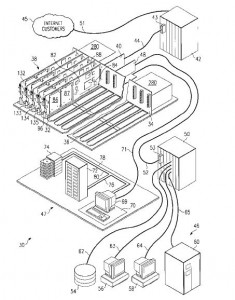 As I mentioned yesterday, one of my fellow bloggers, Stephen Foskett, is writing a series on blade servers. His latest post reveals the history of the blade server. Stephen’s article challenged me to do some research of my own – and here’s what I found. Apparently the first “official” patent for a server on blade (patent # 6,411,506 – “High density web server chassis system and method) was awarded in June of 2002 to Christopher G. Hipp and David M. Kirkeby of RLX Technologies. One interesting fact is that U.S. Patents referenced within the document refers to other patents from many leaders of the industry including IBM, Hewlett-Packard, Micron, Hitachi and even Dell.
As I mentioned yesterday, one of my fellow bloggers, Stephen Foskett, is writing a series on blade servers. His latest post reveals the history of the blade server. Stephen’s article challenged me to do some research of my own – and here’s what I found. Apparently the first “official” patent for a server on blade (patent # 6,411,506 – “High density web server chassis system and method) was awarded in June of 2002 to Christopher G. Hipp and David M. Kirkeby of RLX Technologies. One interesting fact is that U.S. Patents referenced within the document refers to other patents from many leaders of the industry including IBM, Hewlett-Packard, Micron, Hitachi and even Dell.
I’ve taken the liberty of downloading the entire patent document for your reference:
High Density Web Server Chassis – Patent 6411506 B1 (1.84Mb, PDF).
If you like technology and are a history buff, I recommend you check out Stephen’s article at http://blog.fosketts.net/2012/02/20/blade-server-history/.
Kevin Houston is the founder and Editor-in-Chief of BladesMadeSimple.com. He has over 15 years of experience in the x86 server marketplace. Since 1997 Kevin has worked at several resellers in the Atlanta area, and has a vast array of competitive x86 server knowledge and certifications as well as an in-depth understanding of VMware and Citrix virtualization. Kevin works for Dell as a Server Specialist covering the Global 500 East market.
What Is a Blade Server?
 My friend, Stephen Foskett, is writing a series of posts introducing blade servers. It’s probably something I should have done a long time ago, but since I’m a slacker and he beat me to it, I’ll give him kudos and do a re-post. I encourage you to read the full article as it’s very enlightening. Here is an excerpt:
My friend, Stephen Foskett, is writing a series of posts introducing blade servers. It’s probably something I should have done a long time ago, but since I’m a slacker and he beat me to it, I’ll give him kudos and do a re-post. I encourage you to read the full article as it’s very enlightening. Here is an excerpt:
“I’ve been watching enterprise IT for over 20 years now, and I’ve seen some radical changes. In the server space, one of the biggest shifts was the form factor of the servers: From tower to rack-mount to blades. But what makes a blade server anyway? Let’s consider this for a moment, as we watch another shift in progress. Blade servers are easily recognized in the data centers, trade shows, and product catalogs of today: They’re the ones that nestle together in an enclosure, sharing some resources rather than standing on their own in a rack or on the floor. But what is the essential element that separates a blade from any other kind of server?”
Read the rest at http://blog.fosketts.net/2012/02/18/blade-server/
Kevin Houston is the founder and Editor-in-Chief of BladesMadeSimple.com. He has over 15 years of experience in the x86 server marketplace. Since 1997 Kevin has worked at several resellers in the Atlanta area, and has a vast array of competitive x86 server knowledge and certifications as well as an in-depth understanding of VMware and Citrix virtualization. Kevin works for Dell as a Server Specialist covering the Global 500 East market.
Cisco To Launch Next Generation UCS Blade Servers on March 6, 2012
According to a recent event posting by Cisco, the 3rd generation of Cisco UCS blade servers will be revealed on March 6, 2012. The server launch event advertises that Cisco will announce the B200 M3 blade server, and C220 M3, and C240 M3 rack servers on March 6th, 2012. These soon-to-be-announced servers are 2 socket servers built on Intel’s upcoming E5-2600 Romley processors and Patsburg chipsets.
Kevin Houston is the founder and Editor-in-Chief of BladesMadeSimple.com. He has over 15 years of experience in the x86 server marketplace. Since 1997 Kevin has worked at several resellers in the Atlanta area, and has a vast array of competitive x86 server knowledge and certifications as well as an in-depth understanding of VMware and Citrix virtualization. Kevin works for Dell as a Server Specialist covering the Global 500 East market.
Cisco Announces Field Replacement of B440 Blade Servers
Cisco announced on Jan. 26, 2012 a field replacement program for Cisco UCS B440 Blade Servers. Cisco Field Notice FN – 63430 describes the problem as a failure of a MOSFET, or Metal–Oxide–Semiconductor Field-Effect Transistor, power transistor on the blade server that can cause the component to overheat and emit a short flash which could lead to complete board failure. According to Cisco.com, Cisco is directly contacting UCS B440 Blade Server customers and will replace UCS B440 Blade Servers currently deployed at customer sites. Cisco is making UCS B440 Blade Server hardware modifications, and a hardware replacement program has been launched.
To identify the affected systems and any available workaround, please visit the Cisco Field Notice at http://www.cisco.com/en/US/ts/fn/634/fn63430.html
Kevin Houston is the founder and Editor-in-Chief of BladesMadeSimple.com. He has over 15 years of experience in the x86 server marketplace. Since 1997 Kevin has worked at several resellers in the Atlanta area, and has a vast array of competitive x86 server knowledge and certifications as well as an in-depth understanding of VMware and Citrix virtualization. Kevin works for Dell as a Server Specialist covering the Global 500 East market.
deviated septum surgery
christmas tree tax
google redirect virus
bowling green ky
free printable grocery coupons
Own a Piece of World of Warcraft
Blizzard Entertainment recently announced they are auctioning off some older HP blade servers that previously hosted the popular World of Warcraft (WoW) game with 100% of the proceeds going to St. Jude Children’s Research Hospital®. While it is great to own a piece of WoW history, keep in mind, these servers won’t do you any good for use without a minimum of a HP BladeSystem chassis, power supplies and ethernet modules. Here are the details of the auctions found at http://stores.ebay.com/Blizzard-Blade-Servers:
- Display is approximately 28” x 10.3” x 1.7” and weighs 18lbs.
-
Each case is exactly the same for all blade servers being auctioned.
-
Plaques will show the Realm Name and Mo/Yr of start and end date.
-
The copy on the plaque varies. An example of one reads: Blizzard Entertainment has carefully preserved and archived our retired server blades, releasing only a limited number for a noble cause. To us, this server blade is more than just hardware: within the circuits and hard drive, a world of magic, adventure, and friendship thrived. From fishing in quiet lakes to defeating Arthas in Icecrown Citadel, this blade was home to thousands of immersive experiences across the world of Azeroth and beyond. We thank you for the safekeeping of this important part of history.
-
The signatures are printed on the plaque are not original and include the World of Warcraft team.
Current bids range from $107 to $225. Details of the blade server configuration is not provided, however I would speculate, 2 x Intel 5400 CPUs with 64GB of RAM and 6 Network Interface Cards (NICs.) UPDATE – one of our readers, Marrtins, commented below that he received a response from the auction that, “I apologize but these server blades are non-working. All memory has been wiped and they are non-functioning. They are strictly pieces of art.”
The auction runs through January 30, so go to http://stores.ebay.com/Blizzard-Blade-Servers and place your bids while you can!
HP Flex 10 vs VMware vSphere Network I/O Control for VDI
I once was a huge fan of HP’s Virtual Connect Flex-10 10Gb Ethernet Modules but with the new enhancements to VMware vSphere 5, I don’t think I would recommend for virtual environments anymore. The ability to divide the two onboard network cards up to 8 NICS was a great feature and still is, if you have to do physical deployments of servers. I do realize that there is the HP Virtual Connect FlexFabric 10Gb/24-port Module but I live in the land of iSCSI and NFS so that is off the table for me.
With vSphere 5.0, VMware improved on its Continue reading
Q3 2011 IDC Worldwide – Steady as She Goes
Hot off the presses is the latest IDC worldwide server market revenue report for Q3 2011. The gist of the report is that while some of the numbers are slightly adjusted, really not much has changed in the blade server market.
Revenue growth for the entire server market (all servers, not just blade servers) slowed considerably showing only 4.2% year over year growth bringing in $12.7 billion. Growth in the world of servers continues but this marks the slowest growth rate for any quarter since Q1 2010. IDC believes that overall server sales will continue to decelerate due to weakening economic conditions around the globe. “After nearly two years of steady revenue growth, the server market began to decelerate in Q3 2011 as demand stabilized for many system categories,” said Matt Eastwood, group VP and general manager. Incidentally, IBM and HP are both holding steady, tied for the #1 spot in revenue share, at 29.8%.
When looking at the blade server market specifically, growth was steady for Q3 2011 but not as explosive as Q2 2011. IDC reports “solid growth” in the quarter with a revenue increase of 16.4% year over year (vs 26.9% growth in 2Q11). Shipments increased 2.4% (vs 6.2% reported growth for 2Q11). One thing that hasn’t changed since last quarter is that 89% of all blade revenue is driven by x86 systems. Also, blade server sales representing 20.8% of all x86 server revenue. This shows continued steady growth for the blade server segment but that the pace may be slowing slightly.
#1 market share: HP managed to hold the majority margin moving to 51.0% in Q3 2011 from 51.9% in Q2 2011.
#2 market share: IBM continues to see its margin chipped away slightly down to 18.5% in Q3 2011 from 19.1% in Q2 2011.
#3 market share: Cisco’s disruptive market penetration seems to have slowed at 10.7% overall compared to a solid 10% in Q2 2011.
#4 market share: Even Dell dropped slightly to 7.2% revenue share from 8.2% last quarter.
In looking at the totals, the top four vendors represented 87.4% of the revenue share in the blade servers market which is actually down 2% from last quarter. Cisco grew revenue share by less than 1% which means that some of the displacement of the remaining top vendors is not accounted for. Does this mean there may be some new players in the “others” category that we should be watching? Without a detailed breakdown it’s hard to tell but I’ll definitely be looking forward to comparing the numbers next quarter to see if the trend continues. It could, after all, just be a factor of the margin of error in the statistics.
According to Jed Scaramella, research manager, Enterprise Servers at IDC, “Blade systems represented the fastest growing segment in the server industry and now account for 16.0% of total server revenue – a historic high.”
Probably the most interesting aspect of the report is the introduction of hyper-scale servers. “Hyper-scale servers are designed for large scale datacenters with streamlined system designs that focus on performance, energy efficiency, and density.” This sounds like the mantra for blade servers with the main difference being the lack of management and high availability capabilities at the hardware level. Basically these represent the miles of simple, rack mount commodity servers used by the likes of Google and Facebook. This is a $428 million dollar server segment and growing.
For the full IDC report covering the Q2 2011 Worldwide Server Market, please visit IDC’s website at http://www.idc.com.
Why Blade Servers Will be the Core of Future Data Centers
In 1965, Gordon Moore predicted that engineers would be able to double the number of components on a microchip every two years. Known as Moore’s law, his prediction has come true – processors are continuing to become faster each year while the components are becoming smaller and smaller. In the footprint of the original ENIAC computer, we can today fit thousands of CPUs that offer a trillion more computes per seconds at a fraction of the cost. This continued trend is allowing server manufactures to shrink the footprint of the typical x86 blade server allowing more I/O expansion, more CPUs and more memory. Will this continued trend allow blade servers to gain market share, or could it possibly be the end of rack servers? My vision of the next generation data center could answer that question.
